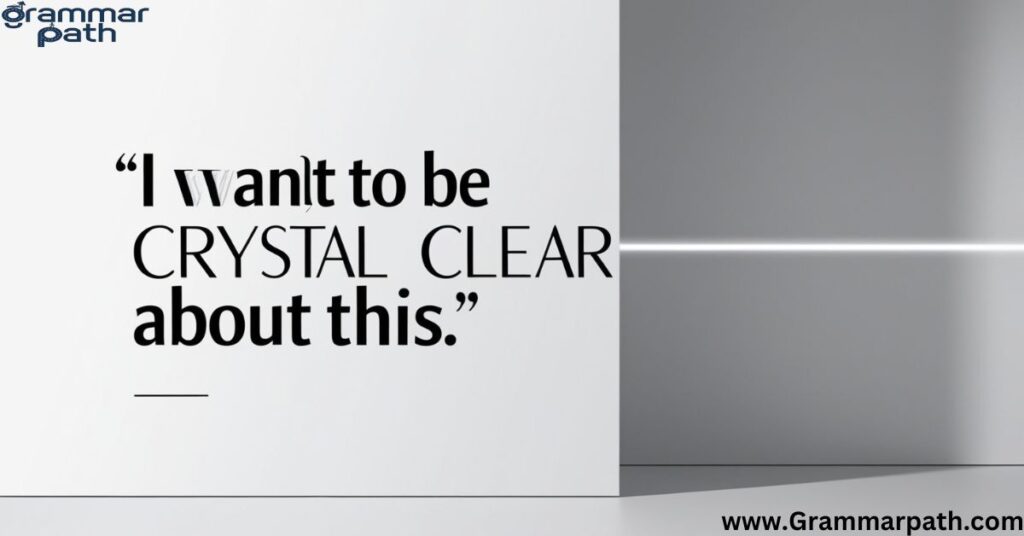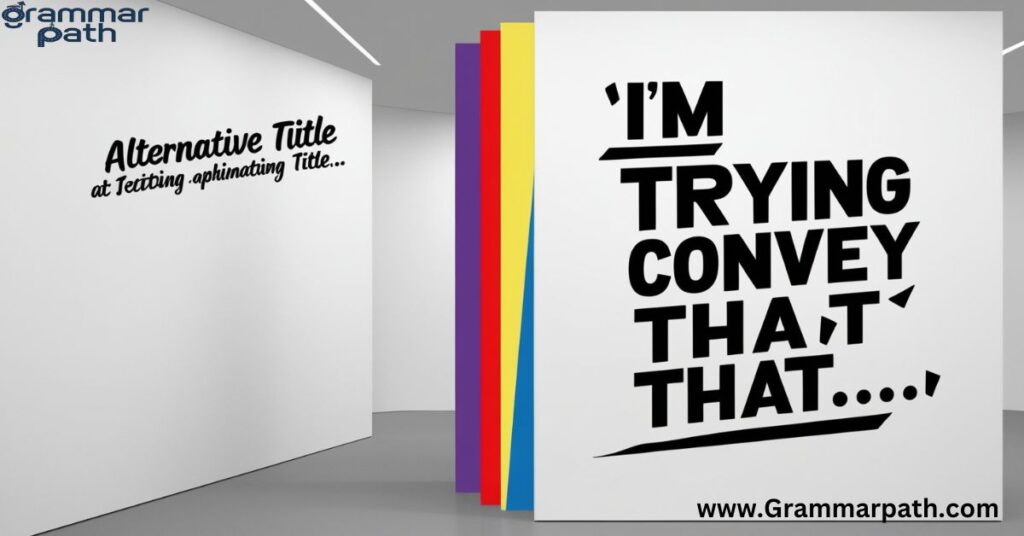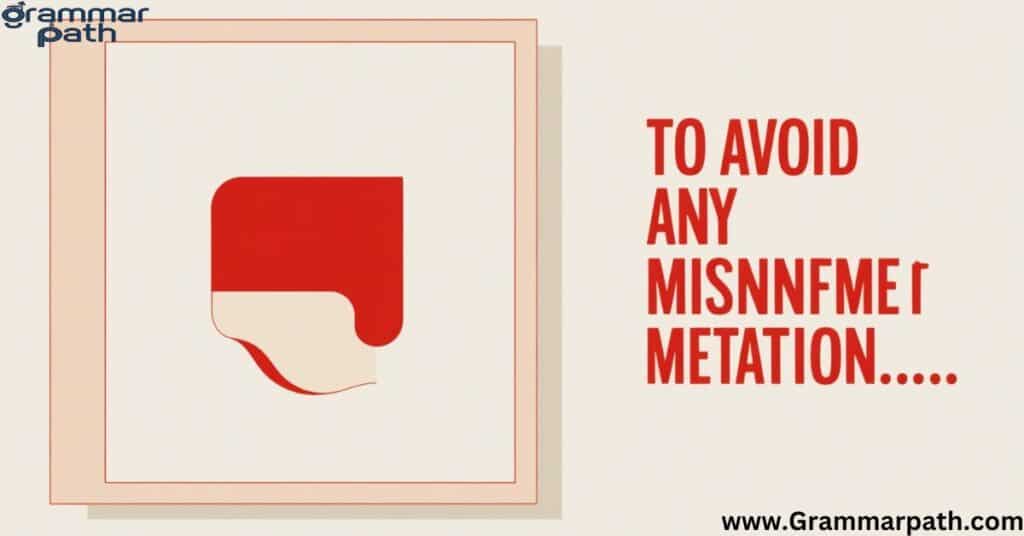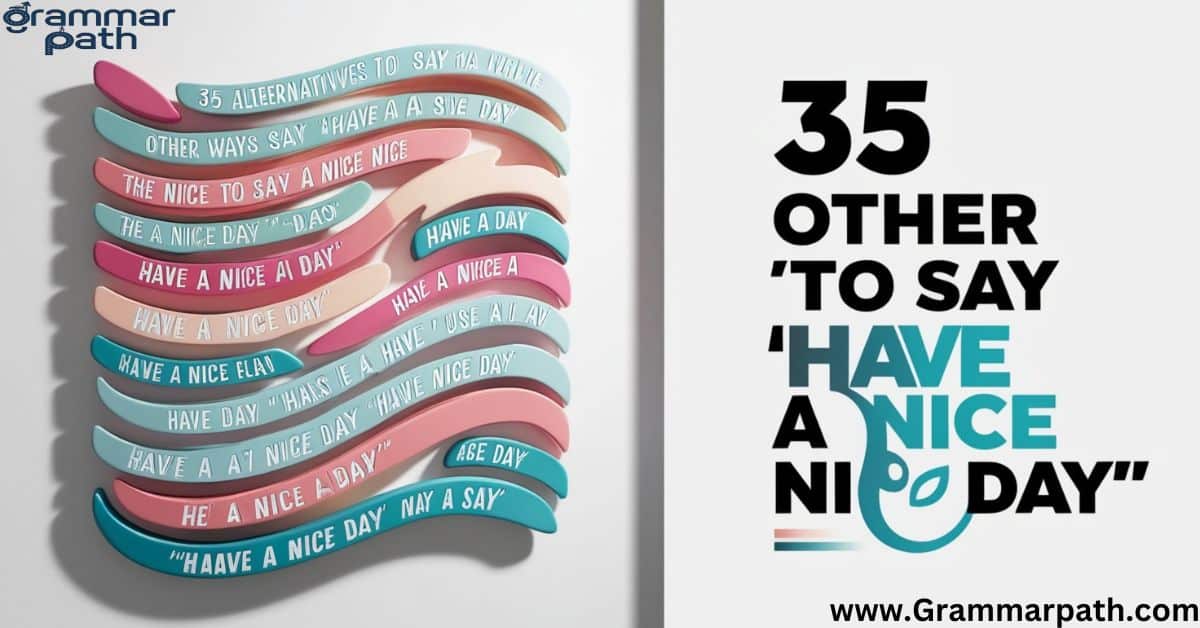
30 Other Ways to Say “Don’t Get Me Wrong”
Communication is an art, and finding the right words to express ourselves clearly can be tricky. We’ve all been in situations where we need to clarify our thoughts without causing offense. That’s where phrases like “don’t get me wrong” come in handy. But let’s face it, using the same expression over and over can get stale.
This article will explore 30 fresh alternatives to “don’t get me wrong” that’ll help you navigate delicate conversations with finesse. Whether you’re writing an email, chatting with friends, or speaking in a professional setting, these phrases will give you the tools to express yourself clearly and thoughtfully.
So, let’s dive in and discover some new ways to ensure your message hits the mark. From casual to formal, we’ve got you covered with a range of alternatives that’ll fit any situation. Get ready to upgrade your communication game!
is it Professional to Say: “Don’t Get Me Wrong”
While “don’t get me wrong” is a common phrase, it’s not always the most professional choice in formal settings. It can sound defensive or imply potential misunderstanding.
In professional contexts, it’s often better to use clearer, more direct alternatives that convey your point without the casual tone. opt for phrases like “To clarify,” or “Let me rephrase that” to maintain a polished, articulate demeanor in workplace communications.
What to Say Instead of “Don’t Get Me Wrong”
- I’d like to clarify my point
- Let me rephrase that
- To put it another way
- I hope I’m expressing myself clearly
- Just to ensure we’re on the same page
- I want to emphasize that…
- Allow me to elaborate on that
- I didn’t mean to imply…
- Let’s look at this from another angle
- I’d like to add some context
- To avoid any confusion…
- I want to be crystal clear about this
- Let me break it down a bit more
- I’m not criticizing, I’m observing
- To put it in perspective…
- I want to make sure I’m not misunderstood
- Let’s take a step back for a moment
- I’m trying to convey that…
- To clarify my stance…
- I’m not suggesting… Rather, I’m proposing…
- Let me put it this way…
- I hope this comes across the right way…
- I want to make a distinction here
- Let me paint a clearer picture
- I’m not downplaying… I’m highlighting…
- To put it in context…
- I want to stress that…
- Let’s unpack that a bit
- I’m trying to draw a distinction between…
- To avoid any misinterpretation…
“30 Thoughtful & Unique Alternatives to ‘Don’t Get Me Wrong’ 💬✨—Express Yourself Clearly and Avoid Misunderstandings!”
Here are “30 Thoughtful & Unique Alternatives to ‘Don’t Get Me Wrong’ 💬✨—Express Yourself Clearly and Avoid Misunderstandings!”:
1. “I’d like to clarify my point”
This phrase is perfect for professional settings where precision matters. It signals that you’re about to provide additional context or explanation.
Example in an email:
Subject: Project Timeline Update
Dear Team,
I’d like to clarify my point about the project deadline. While I emphasized the importance of speed, I didn’t mean to suggest we should rush through important steps. Quality remains our top priority.

2. “Let me rephrase that”
Use this when you realize your initial statement might have been unclear or could be misinterpreted.
Example in a meeting:
“Let me rephrase that. When I said the design was ‘interesting,’ I meant it’s innovative and pushes boundaries in a good way. I’m excited about its potential.”
3. “To put it another way”
This alternative helps you approach your point from a different angle, offering a fresh perspective.
Example in a presentation:
“Our sales have plateaued. To put it another way, we’ve hit a ceiling in our current market and need to explore new opportunities for growth.”
4. “I hope I’m expressing myself clearly”
This phrase shows you care about being understood and invites the listener to seek clarification if needed.
Example in a parent-teacher conference:
“I hope I’m expressing myself clearly when I say that Timmy isn’t struggling academically. Rather, he’s not being challenged enough and might benefit from more advanced material.”
5. “Just to ensure we’re on the same page“
Use this to check in with your audience and make sure your message is getting through as intended.
Example in a team huddle:
“Just to ensure we’re on the same page, when I talk about ‘aggressive growth,’ I’m referring to our expansion into new markets, not cutting corners or compromising our values.”
6. “I want to emphasize that…”
The phrase “Don’t get me wrong” helps you highlight a crucial point that you don’t want to be overlooked or misunderstood.
Example in a customer service email:
Subject: Regarding Your Recent Purchase
Dear Ms. Johnson,
I want to emphasize that our 30-day return policy is designed with your satisfaction in mind. We’re not trying to pressure you into a quick decision, but rather give you ample time to ensure the product meets your needs.

7. “Allow me to elaborate on that”
“When you need to provide more details to prevent misunderstandings, don’t get me wrong, this phrase sets the stage for a deeper explanation.”
Example in a job interview:
“Allow me to elaborate on my experience with project management. While I haven’t held an official PM title, I’ve successfully led several cross-functional teams to complete complex initiatives on time and under budget.”
8. “I didn’t mean to imply…”
Use this when you realize your words might have unintentionally suggested something you didn’t intend.
Example in a friendly conversation:
“I didn’t mean to imply that your cooking isn’t good! When I suggested trying a new recipe, I was thinking we could explore something fun together, not criticize your skills.”
9. “Let’s look at this from another angle“
The phrase “Don’t get me wrong” helps shift perspective and can be useful when you want to present a different viewpoint without dismissing the current one.
Example in a brainstorming session:
“Let’s look at this from another angle. Instead of focusing on cutting costs, what if we explored ways to increase value for our customers? This might lead to higher profits without compromising quality.”
10. “I’d like to add some context“
“When you need to provide background information to ensure your point is fully understood, don’t get me wrong, this phrase sets the stage for a more comprehensive explanation.”
Example in a work email:
Subject: Regarding the Recent Policy Change
Dear Team,
I’d like to add some context to the new work-from-home policy. While it might seem restrictive at first glance, it’s actually designed to create a more flexible and equitable system for everyone in the long run.
11. “To avoid any confusion…”
This phrase signals that you’re about to clarify a point that could potentially be misunderstood.
Example in a client meeting:
“To avoid any confusion, when we discuss ‘aggressive marketing strategies,’ we’re not talking about spamming or intrusive tactics. We’re focusing on data-driven, targeted approaches that respect our audience’s preferences.”
12. “I want to be crystal clear about this”
Use this when you need to make a point with absolute clarity, leaving no room for misinterpretation.
Example in a team update:
“I want to be crystal clear about this: the upcoming reorganization isn’t about cutting jobs. It’s about aligning our structure with our new strategic goals to foster growth and create new opportunities.”

13. “Let me break it down a bit more”
This casual phrase is perfect for when you need to simplify a complex idea or provide step-by-step explanation.
Example in a tutorial video:
“Let me break it down a bit more. When we talk about SEO, we’re not just stuffing keywords into content. It’s about creating valuable, relevant content that naturally incorporates terms your audience is searching for.”
14. “I’m not criticizing, I’m observing”
Use this when you want to provide feedback or point out an issue without sounding negative or judgmental.
Example in a performance review:
“I’m not criticizing, I’m observing that your reports often come in at the last minute. I’m wondering if there’s a way we can adjust your workflow to reduce time pressure and stress.”
15. “To put it in perspective…”
“Don’t get me wrong, this phrase helps you frame your point within a broader context, often useful when discussing complex or sensitive topics.”
Example in a financial planning session:
“To put it in perspective, while the initial investment in renewable energy systems seems high, the long-term savings and environmental benefits far outweigh the upfront costs.”
16. “I want to make sure I’m not misunderstood“
This phrase shows your commitment to clear communication and invites clarification if needed.
Example in a relationship conversation:
“I want to make sure I’m not misunderstood. When I say I need more space, I’m not pulling away from our relationship. I’m just asking for some time to pursue personal hobbies and recharge.”
17. “Let’s take a step back for a moment”
Use this when you want to pause and provide a broader view or additional context to your point.
Example in a strategy meeting:
“Let’s take a step back for a moment. While we’ve been focusing on short-term gains, we need to consider how these decisions align with our long-term vision and values.”
18. “I’m trying to convey that…”
“Don’t get me wrong, this phrase shows that you’re making an effort to express a potentially complex or nuanced idea.”
Example in a mentoring session:
“I’m trying to convey that success isn’t just about reaching goals, but also about the person you become in the process. It’s the skills you develop and the resilience you build that truly matter.”

19. “To clarify my stance…”
Use this when you want to make your position on a matter unmistakably clear.
Example in a policy debate:
“To clarify my stance, I support environmental regulations not because I’m against business, but because I believe sustainable practices lead to long-term economic stability and growth.”
20. “I’m not suggesting… Rather, I’m proposing…”
This phrase helps you differentiate between what you’re not saying and what you are saying, preventing misunderstandings.
Example in a product development meeting:
“I’m not suggesting we scrap the entire project. Rather, I’m proposing we pivot our approach to better align with the feedback we’ve received from beta testers.”
21. “Let me put it this way…”
This casual phrase introduces an alternative explanation, often used when you’re trying to simplify a complex idea.
Example in a sales pitch:
“Let me put it this way: our software isn’t just a tool, it’s like having a tireless assistant who works 24/7 to keep your data organized and your team in sync.”
22. “I hope this comes across the right way…”
Use this when you’re about to say something that could potentially be sensitive or misinterpreted.
Example in a feedback session:
“I hope this comes across the right way, but I’ve noticed that your presentations, while informative, tend to run long. I wonder if we could work on tightening them up to keep our meetings more focused and efficient?”
23. “I want to make a distinction here”
Use this phrase when you need to differentiate between two similar but distinct ideas or concepts.
Example in a team meeting: “I want to make a distinction here. When we talk about increasing productivity, we’re not asking people to work longer hours. Instead, we’re looking at ways to work smarter and more efficiently during our regular hours.”
24. “Let me paint a clearer picture“
This vivid phrase is perfect for when you want to provide a more detailed or illustrative explanation of your point.
Example in a marketing presentation: “Let me paint a clearer picture of our target demographic. We’re not just targeting young professionals; we’re focusing on tech-savvy millennials who value experiences over possessions and are willing to pay for quality and convenience.”

25. “I’m not downplaying… I’m highlighting…”
Use this when you want to emphasize one aspect of a situation without dismissing another.
Example in a project retrospective: “I’m not downplaying the challenges we faced. I’m highlighting how our team’s resilience and creativity turned those obstacles into opportunities for innovation.”
26. “To put it in context…”
This phrase helps you frame your statement within a broader perspective, providing necessary background information.
Example in a historical discussion: “To put it in context, when we discuss the Industrial Revolution’s impact, we’re not just talking about technological advancements. We’re examining a fundamental shift in social structures, economic systems, and even the concept of work itself.”
27. “I want to stress that…”
“Use don’t get me wrong when you need to emphasize a crucial point that you don’t want to be overlooked or misunderstood.”
Example in a safety briefing: “I want to stress that these new protocols aren’t just bureaucratic red tape. They’re carefully designed measures to ensure everyone’s safety and well-being on the job site.”
28. “Let’s unpack that a bit”
This casual phrase is great for breaking down complex ideas into more manageable parts for discussion.
Example in a therapy session: “You mentioned feeling overwhelmed at work. Let’s unpack that a bit. Are we talking about the volume of tasks, the complexity of projects, or perhaps challenges with time management?”
29. “I’m trying to draw a distinction between…”
Use this when you need to clearly separate two ideas that might be easily confused or conflated.
Example in a legal explanation: “I’m trying to draw a distinction between ‘fair use’ and copyright infringement. While both involve using someone else’s work, fair use is a legal doctrine that allows limited use under certain circumstances, whereas infringement is unauthorized use that violates copyright law.”
30. “To avoid any misinterpretation…”
This phrase signals that you’re about to clarify a point that could potentially be misconstrued.
Example in a performance review: “To avoid any misinterpretation, when I say your work is ‘satisfactory,’ I mean it meets our high standards. It’s not a criticism, but an acknowledgment that you’re consistently performing at the level we expect from our top employees.”

Conclusion
In conclusion, mastering the art of clear communication is crucial in both personal and professional settings. These 30 alternatives to “don’t get me wrong” offer a variety of ways to express yourself clearly, avoid misunderstandings, and navigate delicate conversations with tact and precision.
Remember, the key to effective communication isn’t just in the words you choose, but also in how you deliver them. Pay attention to your tone, body language, and the context of your conversation. Be sincere in your efforts to clarify and understand, and you’ll find that these phrases become powerful tools in your communication arsenal.
Whether you’re writing an important email, giving a presentation, or having a heart-to-heart with a friend, these alternatives will help you express your thoughts with clarity and consideration. So go ahead, give them a try, and watch as your conversations become more productive, your relationships stronger, and your messages clearer than ever before.

Emily Olivia is an experienced writer specializing in grammar and English language topics. With a passion for clarity and precision, she shares valuable insights on synonyms, grammar rules, and writing tips to help readers enhance their language skills on Grammar Path.





